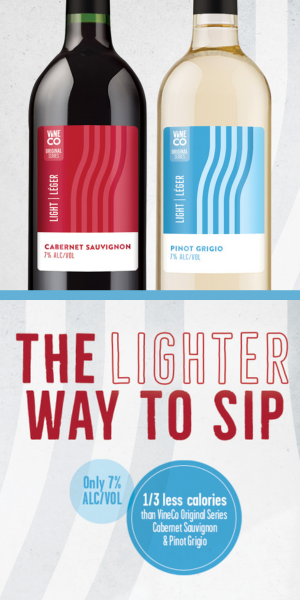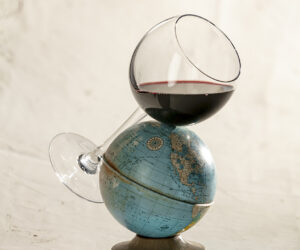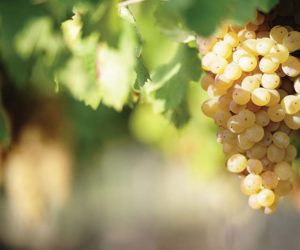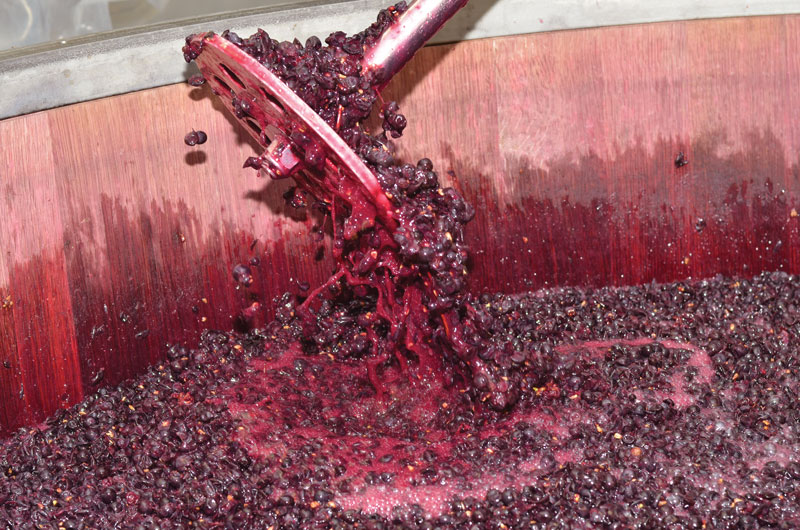In the unpredictable and sometimes wild world of winery consulting, you can never assume what a client may desire or envision for their winery. I started off as a consultant for Hawk Ridge Winery in 2017, and in the years since, it has transitioned into my full-time place of work after the onset of the pandemic put a bit of a damper on traveling consulting work. When first starting and getting to know the varieties planted in the vineyard, all were familiar hybrids to me, except for one variety: A table grape known as Jupiter.
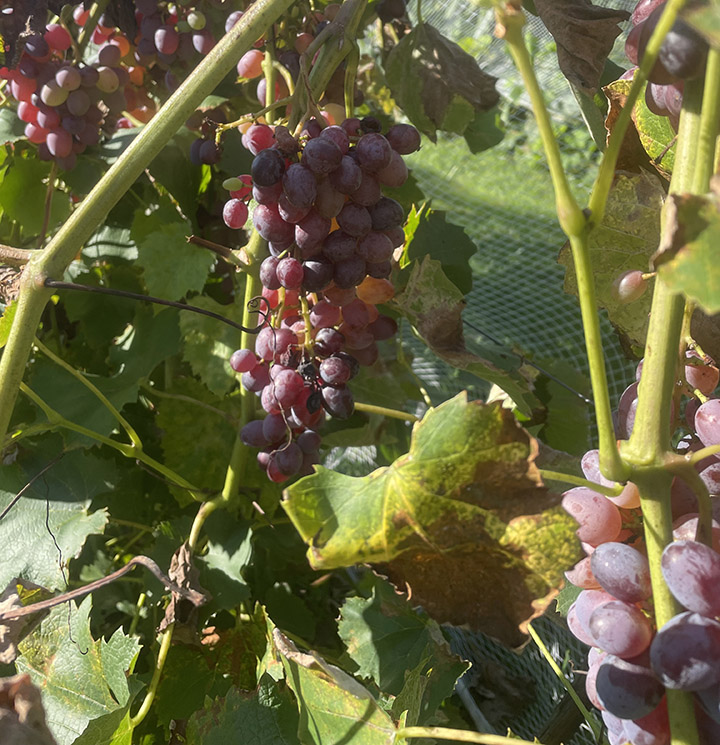
The owner had come across this variety at another, now defunct winery, and had fallen in love with its flavor in wine form and also its versatility as a potential table grape crop. His vision for the grape at Hawk Ridge was a unique variety for wine production and a visually appealing grape for culinary use in the kitchen on cheeseboards and for homemade jelly to accompany charcuterie. After sampling the grape and learning about the table grapes’ physical makeup, I was very curious about it from an enological standpoint. Would this be a worthwhile candidate for winemaking? Would we be able to keep it fresh enough post-harvest for prolonged use in our kitchen?
After years of working with the grape and learning its heritage and nuance, I’ve concluded the answer to these questions is a resounding “yes.” It has quickly become one of my favorite crops on the farm, with often mixed results in terms of yields and ripeness but an overall worthwhile endeavor. While it is a more delicate crop than some of my French-American hybrid varieties, its complex flavors, aromas, and colors are worth all of the extra efforts.
Jupiter was developed at the University of Arkansas by J. Clark and J. Moore, viticulturalists specializing in hybrid table grapes. Clark cross-bred the first prototype of the grape in 1984, an interspecific hybrid of the Vitis labrusca Reliance variety and the Vitis vinifera Gold variety. He and his counterpart Moore were able to maintain the seedless character and cold tolerance traits of Reliance but successfully incorporated the beautiful floral Muscat flavor profile of Gold, a vinifera table grape variety predominantly found in the U.S. After years of development and trials at the University of Arkansas and Purdue University, clones of the grape became available for sale in 1998.
In the Vineyard
The Jupiter variety can be a wonderful addition to any cool-climate vineyard or home garden for its resilience to cold temperatures. It is able to withstand lows of -22 °F (-30 °C). It is advisable to plant in an area that is protected and buffered from intense winds, as when the grape ripens, it tends to lose its tensile strength. I’ve seen strong winds blow the beautifully ripened grapes right off the vine. The vine prefers dry but nutrient-rich soil. It needs very little water to flourish and greatly benefits with better fruit set from applications of basic fertilizer mix or ash in the late fall and early spring. The vines are reddish to chestnut brown in color and have large, dark green leaves with three distinct lobes.
The Jupiter grapes are deep magenta to blue upon maturation and have winged, cone-shaped clusters. The individual berries are large showstoppers, approximately 5–7 grams each in weight. They have a slight teardrop shape, which coupled with their stunning fuchsia color, make a beautiful grape on the vine and on the plate.
Initially in vineyard trials at the University of Arkansas and Purdue University, grapes were grown on Kniffin and bilateral cordon trellising systems. The grape variety can produce clusters weighing 10.5 oz. (300 g) each, making for a heavy canopy in need of sturdy support from a trellis. At Hawk Ridge, we prefer the bilateral cordon trellising system. I find that the top wire cordon strategy that works the top of the plant can help to shield the berries from the wind as they ripen and having the clusters at torso height makes for easy picking. The foliage can get prolific on soils with a high nitrogen content, which can make leaf pulling necessary in the summer months.
One of the dramatic benefits of the Jupiter grape is its short growing season. On average, it takes approximately 100 days to reach ripeness from bud break. This often puts harvest in August or in the northernmost regions of the U.S., early September. With generous yields of 12 lbs. (5.4 kg) per plant, we average almost a ton of grapes annually from our 150 Jupiter vines. To compare, vinifera often takes 4–6 months to ripen fully, and averages 7–15 lbs. (3.2–6.8 kg) per plant, or 3-4 tons per acre. The grapes are non-slip skin variety and have a thinner skin thickness with white interior. If using Jupiter grapes in wine production, your best option would be for a white or rosé wine, as the skins aren’t thick enough to contribute enough anthocyanins for red wine pigmentation.
Jupiter grapevines do very well against mildews and other vineyard pests. I have found it to be mildly susceptible to powdery mildew, especially later in the season. Even with a spray program that is applied every 10–14 days, bits of the mildew still appear in years with heavier precipitation and the powdery mildew can take its toll on the leaves. This often coincides with harvest of the grapes, so any negative effects on the leaves do not have a deleterious effect on the crop. The grapes are also very bright pink to deep blue in color upon ripening, which can make them an easy target for wasps. The intense aroma that attracts me to the vines, unfortunately also attracts the wasps, which means you need to be extra careful picking. Other local wildlife also seem drawn to the grapes. Even though we netted, we lost an entire crop of Jupiter one season to a pack of hungry animals (I assume raccoons or starlings) that ate over 1,000 lbs. (450 kg) of grapes in a weekend. Creative pest deterrents may come in handy to protect this vibrant and aromatic crop. I do advise placing pick bins directly under the trellis while harvesting to gather up any grapes that fall off the cluster due to the loss of tensile strength towards ripeness.
In the Winery
Jupiter can be a challenging but incredibly worthwhile experiment to generate a flavorful rosé or white table wine. If immediately crushed and pressed, the juice will make an aromatic white wine base. The Muscat in its lineage really shines through, with intense heady floral notes and touches of spice. If crushed and allowed contact time with the skins, the bright pink and purple skins will contribute a limited amount of their fantastic color and more of the spicy notes to the wine, including nuances of nutmeg. I have conducted various trials with skin contact time and have found that fermenting completely on the skins provides not only the best color up front, but the wine retains color better throughout its aging process. One vintage, I only allowed skin contact for 48 hours, tinting the juice an attractive pink shade, but found that much of the color dropped out over the course of the aging process, resulting in a white wine after about 6–9 months. In more recent vintages, I have fermented completely on the skins and due to their thinner constitution and lower skin-to-flesh ratio, even after fermentation, the resulting wine is a vibrant fuchsia.
The vintner has many opportunities in the lab and winery to truly highlight the perfumy and aromatic Muscat elements of the Jupiter grape. Additions of pectic enzyme to the ferment will help break down the skins and lock in some of the anthocyanins to pigment the wine. Choose a wine yeast that helps to amplify aromatics such as Vin13, BA11, Elixir, or QA23. All of these strains will help to free up aromatic precursors, boosting aroma throughout the fermentation, yielding more berry, floral, and spice qualities. Because this is a table grape, Brix levels at ripeness often do not exceed 21 °Brix, so some chaptalization may be necessary. Last year, my Brix were low, but my acid levels were ideal, coming in at a pH of 3.28 and titratable acidity (TA) of 9 g/L. I rarely need to adjust acids much in my Jupiter, as we have a short growing season and tend to have higher levels of acidity, however, in warmer regions a bit of acid may be needed to create a balance.
Jupiter can create a wine of many styles from a dry rosé table wine to a sweetened dessert-style. There is even potential for a lively sparkling rosé. In a table wine format, you can keep the variety on its own or consider blending with complementary varieties such as Black Muscat, Traminette, Riesling, or another fruit-forward red grape fermented into a rosé. I have used the grape on its own, fermented into wine and then backsweetened to create a complex and delicious dessert-style wine that displays flavors of raspberry sorbet, white florals, and cotton candy. Due to its ability to retain some acidity and complex flavor profiles, I also am optimistic for Jupiter as a potential sparkling wine.
With its short growing season, mildew resistance, seedless quality, beautiful, delicate, and unique flavors, Jupiter is a terrific choice for everyone from the hobby gardener, backyard viticulturalist, to professional winemaker.
Jupiter Rosé Recipe (Yields 5 gallons/19 L)
Ingredients
125 lbs. (57 kg) Jupiter grapes
Sanitizing solution of potassium metabisulfite (KMBS)
5 g yeast (ICV D47, R2, QA23, or BA11)
7.5 g Go-Ferm Sterol Flash
7.5 g Fermaid O
5 g Fermaid K
5 g Opti-White (optional but helps)
5 g Booster Blanc (optional but helps)
5 g bentonite
Potassium bicarbonate
Distilled water
Table sugar (if Brix is low)
Potassium sorbate
Zenith Uno or Celstab (optional)
Equipment
Crusher/destemmer
Wine press
15-gallon (57-L) fermenter
(2) 5-gallon (19-L) carboys
Airlock and bung
Auto-siphon and tubing
Stir paddle
Spray bottle
Punch down tool
pH meter
Hydrometer
Thermometer (digital preferred)
Glass marbles (optional)
Step by step
1. Ensure all your equipment is clean and in proper working order. Make a fresh batch of KMBS sanitizing solution using 1 Tbsp. of KMBS powder and 1 Tbsp. citric acid mixed into 1 gallon (3.8 L) of clean water. Fill a spray bottle with the solution and spray your processing equipment, but ensure there is no pooling of sanitizer in bins or press basins.
2. Crush and destem the grapes. While this procedure is for a rosé style wine, you will ferment completely on the skins.
3. Transfer must into a sanitized fermentation bucket. Add 50 ppm of KMBS to kill off natural yeast. Utilize the sulfite calculator at www.winemakermag.com/sulfitecalculator to assist in your calculations.
4. Take measurements of your must, including volume, Brix, pH, and titratable acidity (TA). Adjust the juice to a starting Brix of 22, a pH of ~3.3, and TA of 8–9 g/L. www.wineadds.com has calculators to assist you with Brix and acidity adjustments.
5. To prepare the yeast, warm 50 mL of distilled water to 60 °F (16 °C) and add to the mixing bowl. Then add the Go Ferm Sterol Flash. Stir well. Then add five grams of yeast and stir well. Allow to sit for 15 minutes. Then mix in thoroughly to the must with a sanitized stir paddle.
6. Place a lid loosely on the fermentation pail and wait 24 hours to observe yeast activity. Take Brix measurements twice daily via a hydrometer to ensure the start of fermentation. Take temperature measurements daily. Punch down the cap three times a day to fully mix the skins back into the must. Try to keep the fermentation temperatures within the optimal temperature window of the yeast strain that you selected. To do this, you may need to put the bin in a cool area of your basement, outdoor porch, or refrigerator, or in a larger bin (garbage pail) filled with ice water.
7. After one or two days of fermentation, check the Brix and if it has dropped by a degree or two, it will be time to add some nutrients. Add 100 mL of distilled water, 7.5 g Fermaid O, and the Opti-White and Booster Blanc (if you are using them) to a mixing bowl. Mix well to create a slurry and then stir into the fermenting juice with a sanitized stir paddle.
8. Continue to monitor Brix and temperature daily (twice daily is preferred). When the Brix has declined to 15–11 °Brix, add the Fermaid K in the same way you added the Fermaid O.
9. Continue to ferment as close to 60 °F (16 °C) as possible until the wine has fermented to dryness (about -1 to -2 °Brix). This should take 7–21 days.
10. Press the wine off of the skins in a sanitized wine press and put into a 5-gallon (19-L) carboy to settle.
11. Rack off the gross lees into a sanitized carboy. Add 50 ppm of KMBS and stir well into the wine. Affix the bung and airlock and allow to sit for 5-7 days in a cool environment.
12. After 5–7 days, rack off the lees into a clean, sanitized carboy. Affix bung and airlock and allow to sit for a month. If you have an air gap after racking, either top off with a complementary wine such as rosé or Muscat wine, or add sanitized glass marbles to displace the headspace.
13. When the wine is one month old, rack again into a sanitized carboy and add another 50 ppm of KMBS. At this point the wine should give off minimal lees and should be hazy but not opaque. Consider fining with bentonite to help clarify it and help with heat stabilization. Mix bentonite according to its directions (every formulation may have its own unique preparation). Add to wine and allow to settle over 2–3 weeks. Once bentonite has settled, rack the wine off the lees into a clean and sanitized carboy.
14. Allow the wine to sit and age, maintaining a free SO2 level appropriate for the pH. WineMaker’s sulfite calculator will help you determine the proper dosage given the parameters of pH and volume. Consider cold stabilizing or adding a cold stabilizing product such as Zenith Uno or CelStab. These products may only be used if the wine is filtered down to 0.5 micron as turbidity will interfere with their effectiveness.
15. Once cold stability has been achieved, taste the wine and see if you desire some sweetness to balance. If you would like to backsweeten, raise the free SO2 to 50 ppm and add 1 g/gallon of potassium sorbate. Stir well, then add whatever amount of sweetener you would like to achieve the desired end result (based on bench trials).
16. Bottle wine once you are content with the flavor and stability of the wine. Always add a small amount of sulfite before bottling — 10 ppm beyond the sulfite calculator’s recommended value — to account for oxygen uptake during the bottling process.

